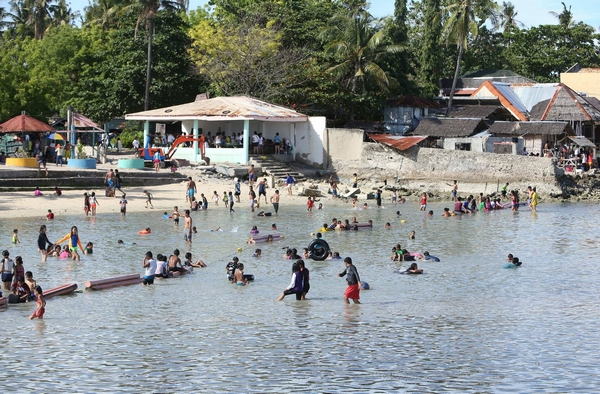Lapu asks EMB: Clarify report on elevated sea coliform level

Beach goers try to beat the summer heat with a dip at the Marigondon beach in Lapu-Lapu City.
Most, but not all water samples obtained by the Environmental Management Bureau in Central Visayas (EMB-7) from the seawaters off Mactan and the island of Panglao in Bohol have failed the standard of fecal coliform contamination.
This was the clarification issued by EMB-7 Regional Director William Cuñado, after a report aired over national TV alleged that all of the 26 water sampling stations of the EMB-7 have exceeded the safe standard for fecal coliform level.
“Dili maayo ang result sa 2017, daghan gyud kaayo. But based on our 2018 results, most of them have already passed the standard,” Cuñado said.
Cuñado said that he already ordered his personnel to conduct an inventory and summary of all the results of water samples that were done in 2017 and 2018 and to come up with a comparative data.
He also informed that they have installed more water sampling stations throughout the region to intensify their monitoring, not only in Mactan and Panglao, but other areas as well.
He said that their central office may just have issued a generalized statement regarding the level of contamination in the region, due to last year’s bad results.
The government’s intensified monitoring on hotels and resorts, especially on their compliance on wastewater discharges and treatment, has resulted to the improvement of the quality of seawater in the region, Cuñado said.
Meanwhile, lawyer Ethelbert Ouano, environmental lawyer of the City Attorney’s Office in Lapu-Lapu City, has urged EMB to explain to them the threshold point in their monitoring when it comes to seawater fecal coliform contamination.
Based on EMB’s standard, fecal coliform level in seawater should not exceed 100 Most Probable Number (MPN) per 100 Milliliter (ML) in order for it to be considered safe.
But the Lapu-Lapu City government is using the 1,000 MPN standard on their monitoring.
“Naay high exceedance, but I guess it’s about time that they also find the cause. It seems it’s like a guessing game,” Ouano said.
Ouano said that it’s important for them to identify the source of pollutants so that they can promptly address the problem.
He said that possible causes of fecal coliform contamination are water currents, high temperature and humans or establishments who throw their waste directly to the sea.
Ouano stressed that everyone is contributory to the problem and that the city government of Lapu-Lapu is looking at different ways to solve the problem.
Disclaimer: The comments uploaded on this site do not necessarily represent or reflect the views of management and owner of Cebudailynews. We reserve the right to exclude comments that we deem to be inconsistent with our editorial standards.
